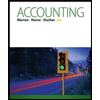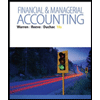
a)
Statement of
Income statement: Income statement is a financial statement that shows the net income or net loss by deducting the expenses from the revenues and vice versa.
To Explain: The differences between cash flows from operating activities and the net income.
b)
To Explain: The accounting method followed by Company T, to record
c)
To Explain: The difference in the accounting method if Company T, followed direct method instead of indirect method, to prepare the statement of cash flows.
d)
To Explain: The difference in the
e)
To Explain: The transactions which do not impact the statement of cash flow of a company.
Want to see the full answer?
Check out a sample textbook solution
Chapter 21 Solutions
INTERMEDIATE ACCOUNTING RMU 9TH EDITION
- How much total cost would be allocated to the Assembly activity cost pool?arrow_forwardDo fast solve this questionarrow_forwardSuppose a stock had an initial price of $66 per share, paid a dividend of $1.8 per share during the year, and had an ending share price of $80. Compute the percentage of total return. a. 23.94% b. 19.75% c. 29.70% d. 25.14%arrow_forward
- Accounting answer with solutionarrow_forwardAccounting answer with correct solutionarrow_forwardValley Tech Inc. reported the following balances at the end of the year: Credit Sales: $250,000 Accounts Receivable: $45,000 Allowance for Uncollectible Accounts before adjustment: $2,000 debit Valley Tech estimates that 5% of the credit sales will be uncollectible. What is the net realizable value of accounts receivable after the year-end adjustment?arrow_forward
- XYZ Co. has an average collection period of 45 days. Total credit sales for the year were $3,200,000. What is the balance in accounts receivable at year-end? (Use 360 days in a year. Round to the nearest dollar.)arrow_forwardProvide Answerarrow_forwardCompute the percentage of total return?arrow_forward
- Compute the net incomearrow_forwardPlease explain the solution to this general accounting problem using the correct accounting principles.arrow_forwardProperty, Plant & Equipment (Non-current Assets) 1.Define PPE and explain its treatment under IAS 16.2.Compare the cost model vs. revaluation model, including pros, cons, and theoretical implications (e.g., relevance vs. reliability).3.Calculate depreciation using both straight-line and reducing balance methods for an asset costing $500,000 with an expected life of 10 years and residual value of $50,000.4.Explain how impairment and disposals affect PPE reporting and financial results.arrow_forward
 Survey of Accounting (Accounting I)AccountingISBN:9781305961883Author:Carl WarrenPublisher:Cengage Learning
Survey of Accounting (Accounting I)AccountingISBN:9781305961883Author:Carl WarrenPublisher:Cengage Learning Accounting (Text Only)AccountingISBN:9781285743615Author:Carl Warren, James M. Reeve, Jonathan DuchacPublisher:Cengage Learning
Accounting (Text Only)AccountingISBN:9781285743615Author:Carl Warren, James M. Reeve, Jonathan DuchacPublisher:Cengage Learning Financial & Managerial AccountingAccountingISBN:9781285866307Author:Carl Warren, James M. Reeve, Jonathan DuchacPublisher:Cengage Learning
Financial & Managerial AccountingAccountingISBN:9781285866307Author:Carl Warren, James M. Reeve, Jonathan DuchacPublisher:Cengage Learning Cornerstones of Financial AccountingAccountingISBN:9781337690881Author:Jay Rich, Jeff JonesPublisher:Cengage Learning
Cornerstones of Financial AccountingAccountingISBN:9781337690881Author:Jay Rich, Jeff JonesPublisher:Cengage Learning AccountingAccountingISBN:9781337272094Author:WARREN, Carl S., Reeve, James M., Duchac, Jonathan E.Publisher:Cengage Learning,
AccountingAccountingISBN:9781337272094Author:WARREN, Carl S., Reeve, James M., Duchac, Jonathan E.Publisher:Cengage Learning, Intermediate Accounting: Reporting And AnalysisAccountingISBN:9781337788281Author:James M. Wahlen, Jefferson P. Jones, Donald PagachPublisher:Cengage Learning
Intermediate Accounting: Reporting And AnalysisAccountingISBN:9781337788281Author:James M. Wahlen, Jefferson P. Jones, Donald PagachPublisher:Cengage Learning





